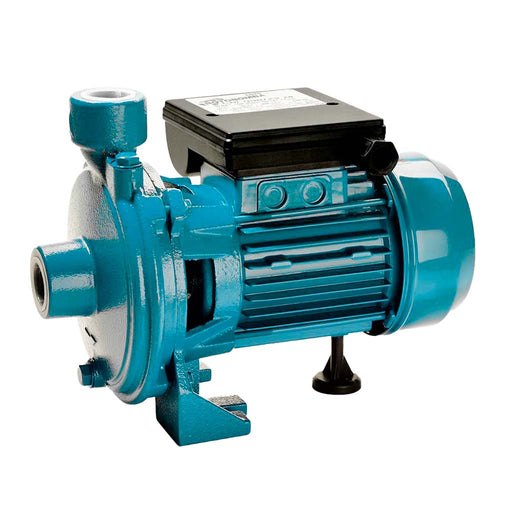Pressure pumps in plumbing are electromechanical devices designed to increase the water pressure in a pipe system, facilitating its distribution. Their operation includes sucking water from a tank and conducting it to an elevated tank or to the hydraulic distribution network, improving the supply in areas with low pressure.
Pressure pumps play a crucial role in many plumbing systems, both in domestic and commercial applications. These devices are essential in situations where the water pressure is insufficient to meet daily needs. Low pressure issues can be common in certain geographic areas, such as tall buildings or rural zones, where distance or height affects water flow. Pressure pumps provide an effective solution, ensuring that water reaches taps, showers, and other points of use with enough force, thus guaranteeing an efficient and comfortable experience for users.
Applications of Pressure Pumps in Plumbing Systems
In residential plumbing systems, a pressure pump can be installed when the water supply is inadequate or irregular. For example, in homes located on the upper floors of a tall building, water pressure tends to drop significantly. In these cases, pressure pumps enhance the flow, ensuring that water reaches elevated areas with sufficient pressure. Additionally, in rural areas where water comes from wells, pressure pumps are necessary to extract water and transport it to the home.
In commercial installations, such as hospitals, office buildings, or shopping centers, pressure pumps are equally vital. In these locations, a reliable plumbing system is required to ensure proper water distribution across multiple floors and areas with high foot traffic. Without an appropriate pressure pump, the water flow may be insufficient to meet demand, affecting both users and the proper operation of systems that rely on it.

Types of Pressure Pumps
There are many types of pressure pumps depending on the type of use, however we have classified them based on the different plumbing needs. Below are some of the most common ones:
Centrifugal Pumps: These pumps are the most commonly used in potable water systems and plumbing. They operate by using centrifugal force to move water through the piping system. They are highly efficient and reliable, making them an ideal choice for residential and commercial applications. Additionally, their ability to handle large volumes of water makes them perfect for tall buildings or large installations.
Submersible Pumps: These pressure pumps are ideal for underground water systems, such as wells. They are placed directly in the water and can extract liquid from significant depths, bringing it to the surface with enough pressure. They are an excellent option in rural areas or homes that rely on private water sources.
Automatic Pressure Pumps: This type of pressure pump is designed to automatically adjust the water flow according to demand. This means that when there is a higher need for water, the pump increases its power, and when demand decreases, it reduces its operation, thus optimizing energy consumption.
Installation and Maintenance
The installation of a pressure pump in a plumbing system is a delicate process that must be carried out carefully. It is crucial that the pump is properly connected to the water supply network and that additional components, such as check valves, are used to ensure that water does not flow backward when the pump is not in operation. Proper installation not only guarantees efficient operation but also the durability of the system as a whole.
Maintenance is another key aspect of using pressure pumps. To avoid performance issues, it is advisable to conduct regular inspections, checking aspects such as connections, pressure levels, and the presence of possible obstructions in the pipes. Cleaning and maintaining the pump properly prevents sediment buildup, which could affect its pumping capacity and reduce its lifespan.

Advantages of Pressure Pumps in Plumbing
Using a pressure pump in a plumbing system offers several significant advantages:
Improved water flow: A pressure pump ensures that water reaches all points of use evenly, even in the most distant or elevated areas of the installation. This improves the user experience when using faucets, showers, and appliances that require a constant and adequate water supply.
Energy efficiency: Modern pressure pumps, especially automatic ones, are designed to optimize energy consumption. By adjusting their operation according to demand, they reduce energy waste, leading to long-term savings.
Durability and reliability: Pressure pumps are built with high-quality materials, ensuring their durability and resistance in demanding conditions. Proper maintenance extends their lifespan and reduces the need for frequent replacements.
Challenges and Solutions
Despite their numerous advantages, using a pressure pump also presents some challenges. For example, incorrect pump sizing can lead to excessive energy consumption or inefficient performance. It is crucial to choose a pump that correctly fits the specific needs of the plumbing system. Additionally, noise problems are common but can be solved by installing vibration dampeners or using quieter pumps.
Conclusion
In summary, pressure pumps are essential components in any plumbing system that requires an improvement in water flow and pressure. Whether in a residential home or a commercial installation, these pumps ensure that water reaches all points of use with the necessary force, improving user experience and ensuring the efficient and reliable operation of the system.
If you would like to continue learning about plumbing, we invite you to read our article on potable water where you will find important information on how to save water with your efficient plumbing system.



0 Comments